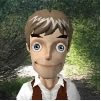
The performance of what is called "early music" is closely tied to the "original instrument" movement. "Early music" usually includes music from the 12th - 15th centuries, and groundbreaking classical researchers, whose extensive scholarship helped sketch out undiscovered performing styles, were pretty much on their own. David Munrow's work arguably began the whole movement, and his "Music of the Gothic Era" is seminal. For many people, their first exposure was David Munrow's soundtrack work for the BBC series "Henry VIII and His Six Wives" (mid- to late-70's).
Researchers eventually realized that they could come up with a reasonable facsimile of what Handel's listeners (for instance) may have heard by performing on instruments of the time, rather than current modern instruments. The earliest experiments were a bit, er, 'pitchy' and many critics wrote off the whole movement as wrong-headed and unmusical, but the best kept getting better, and now the "original instrument" crowd is crowded indeed. The Dufay Collective play a mix of vocal and instrumental pieces, and the vocal style, while a bit "plummy" for my taste, fits well with the overall program.



Istanpitta (there are 2 volumes) by New York's Ensemble for Early Music is an older album than the Dufay collection, so it's not recorded as crisply, but I still think it's a great album. It's more meditative than rousing (though there are some dance pieces).
The grand-daddy of them all is "La Spagna" by Gregorio Paniagua and the Atrium Musicae de Madrid, which is a stunning collection of 41 versions of the "La Spagna" melody from the 15th through the 17th centuries. One thing this disc shares with almost all the others is the wide dynamic range, so when the lutes lull you into a state of calm, there's a barrage of crumhorns and tambors just around the corner. Many variations on this Spanish melody sound Middle Eastern to my ears, but that's the beauty of a well-travelled melody, and no, 41 versions does not make you want to bludgeon yourself senseless.
Part of what made unearthing the performance style of early music difficult was the fact that beyond the basic melody, much of the performance was based on improvisation, tempered to the skill of the musicians. Hesperus experiments with "Neo-Medieval", a mix of scripted and unscripted variations.



Piffaro do a fine juggling act with the subtle and the brazen, with crumhorns buzzing and bagpipes wheezing. Who knew that the bagpipe could play well with other instruments? The Italian collection gets the slight edge for me over the French one, and to round it off, "Lo Splendore D'Italia" by The Whole Noyse covers mostly brass (cornett) and recorder music of the late 15th century.
And we top things off with the Broadside Band, who perform tunes Dickens would insert into "A Christmas Carol" -- party at Fezziwigs!
You may be surprised listening to some of these stellar collections hearing how close the tie is to traditional Irish and English folk; later 'baroque folk' Brits like Bert Jansch and especially John Renbourn rediscover some of these pieces, rearrange them for solo guitar, and suddenly, everything new is olde again!


David, do you have Richard Thompson's "1000 Years of Popular Music"? If not, you'd enjoy it immensely, I have no doubt.
ReplyDelete